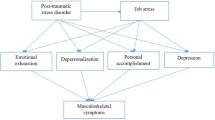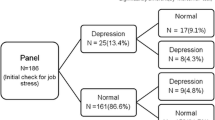Abstract
Objective: The objective of this study was to investigate individual and work-related psychosocial factors associated with changes in the perceived physical and mental strain among fire-fighters. Methods: The 3-year follow-up study, done by a questionnaire, was based on data on 632 fire-fighters. The associations were investigated mainly by logistic regression modelling. Results: Accidents were associated with increased perceived physical as well as mental strain (OR 1.4–2.6). Unfair distribution of work tasks was associated with increased perceived physical strain (OR 8.5, CI 1.5–49.6). Frequent differences of opinion disturbing work (OR 2.7, CI 1.2–6.1) and lack of possibilities for career advancement (OR 4.6, CI=1.0–22.5) were associated with perceived increased mental strain at work. Conclusions: The results suggest that measures to reduce the perceived physical and mental strain of fire-fighters should be multi-factorial. However, to determine the content of the measures needs further intervention studies.
Similar content being viewed by others
References
Act on Occupational Health Services (2001). http://www.finlex.fi, Cited on (21.12.2001/1383)
Bos J, Mol E, Visser B, Frings-Dresen MHW (2004) The physical demands upon (Dutch) fire-fighters in relation to the maximum acceptable energetic workload. Ergonomics 47:446–460
Collins SM, Karasek RA, Costas K (2005) Job strain and autonomic indices of cardiovascular disease risk. Am J Ind Med 48:182–193
Corneil W, Beaton RD, Murphy SA, Johnson LC, Pike K (1999) Exposure to traumatic incidents and prevalence of posttraumatic stress symptomatology in urban fire fighters in two countries. J Occupat Health Psychol 4:131–141
DeJoy DM, Wilson MG (2003) Orgazational health promotion: broadening the horizon of workpalce health promotion. Am J Health Promot 17: 337–241
DeZwart BCH, Frings-Dresen MHW, Van Duivenbooden JC (2002) Test-retest reliability of the work ability index questionnaire. Occup Med 52:177–181
Elo A-L, Leppänen A, Lindström K, Ropponen T (1992) OSQ occupational stress questionnaire: user’s instructions. Finnish Institute of Occupational Health
Elo A-L, Leppänen A, Jahkola A (2003) Validity of a single-item measure of stress symptoms. Scand J Work Environ Health 29:444–451
Elovainio M, Forma P, Kivimäki M, Sinervo T, Sutinen R, Laine M (2005) Job demands and job control as correlates of early retirement thoughts in Finnish social and health care employees. Work Stress 19:84–92
Eskelinen L, Kohvakka A, Merisalo T, Hurri H, Wäger G (1991) Relationship between the self assessment and clinical assessment of health status and work ability. Scand J Work Environ Health 17 (Suppl 1):40–44
Ferrie JE (1999) Health consequences of job insecurity. WHO Reg Publ Eur Ser 81:59–99
Hemingway H, Marmot M (1999) Evidence based cardiology. Psychosocial factors in the aetiology and prognosis of coronary heart disease: a systematic review of prospective cohort studies. BMJ 318:460–467
Ilmarinen J, Tuomi K (2004) Past, present and future of work ability. People Work Res Rep 65:1–15
Johnson JV, Hall EM (1988) Job strain, work place, social support and cardiovascular disease. Am J Public health 78:1336
Karasek RA (1979) Job demands, job decision latitude, and mental strain: implications for job redesign. Adm Sci Q 24:258–308
Kuper H, Marmot M (2003) Job strain, job demands, decision latitude, and risk of coronary heart disease within the Whitehall II study. J Epidemiol Community Health 57:147–153
Lusa S, Häkkänen M, Luukkonen R, Viikari-Juntura E (2002) Perceived physical work capacity, stress, sleep disturbances and occupational accidents among firefighters working during a strike. Work Stress 16:264–274
Lusa S, Punakallio A, Luukkonen R (2004) Factors predicting the perceived work ability of Finnish fire fighters: a three-year follow-up study. In: Ilmarinen J, Lehtinen S (eds) Proceedings of the 1st international symposium on work ability. Past, present and Future of work ability. Finnish Institute of Occupational Health, Helsinki, People and work–research reports 65:96–105
Melius J (2001) Occupational health for fire fighters. Occup Med 16:101–108
Mohren DCL, Swaen GMH, van Amelsvoort LGPM, Borm PJA, Galama JMD (2003) Job insecurity as a risk factor for common infections and health complaints. J Occup Environ Med 45:123–129
Murphy SA, Bond GE, Beaton RD, Murphy J, Johnson LC (2002) Lifestyle practices and stressors as predictors of health outcomes in urban firefighters. Int J Stress Manage 9:311–327
Occupational Safety Act (2002). http://www.finlex.fi, cited on (23.8.2002/738)
Punakallio A, Lusa-Moser S, Louhevaara V (2001) Fire-fighting and rescue work in emerge situations and ergonomics. In: Karwowski W, Marras W (eds) International encyclopedia of ergonomics and human factors, Vol I. Taylor & Francis, London and New York pp 449–453
SAS Institute (1989) SAS user’s guide, Version 6. 4th edn. SAS Institute, Cary
Siegrist J, Peter R, Junge A, Cremer P, Seidel D (1990) Low status control, high effort at work and ischemic heart disease: prospective evidence from blue-collar men. Soc Sci med 31:1127–1134
Statistics Finland (2003) Labour force survey. Helsinki, Finland
Szubert Z, Wojciech S (2002) Work-related injuries among firefighters:sites and circumstances of their occurrence. Int J Occup Med Environment Health 15:49–55
Tuomi K, Ilmarinen J, Seitsamo J, Huuhtanen P, Martikainen R, Nygård CH, Klockars M (1997) Summary of the Finnish research project (1981–1992) to promote the health and work ability of aging workers. Scand J Work Environ Health 23:66–77
Wu HC, Wang M-JJ (2001) Determining the maximum acceptable work duration for high-intensity work. Eur J Appl Physiol 85:339–344
Wu HC, Wang M-JJ (2002) Relationship between maximum acceptable work time and physical workload. Ergonomics 45:280–289
Acknowledgements
The Fire Protection Fund of Finland supported this study financially.
Author information
Authors and Affiliations
Corresponding author
Rights and permissions
About this article
Cite this article
Lusa, S., Punakallio, A., Luukkonen, R. et al. Factors associated with changes in perceived strain at work among fire-fighters: a 3-year follow-up study. Int Arch Occup Environ Health 79, 419–426 (2006). https://doi.org/10.1007/s00420-005-0059-2
Received:
Accepted:
Published:
Issue Date:
DOI: https://doi.org/10.1007/s00420-005-0059-2




